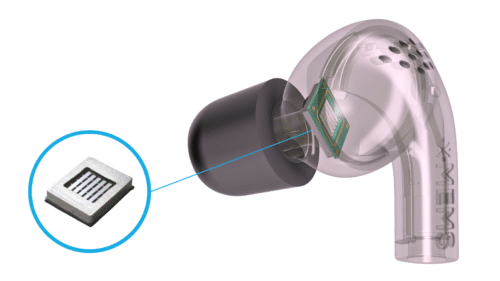The solid-state MEMS speaker uses ultrasonic amplitude modulation to enhance earbud sound quality and revolutionise noise-cancelling technology.

xMEMS Labs has introduced the Cypress solid-state MEMS speaker, changing how earbuds deliver sound across frequencies. This method uses ultrasonic amplitude modulation to convert air pulses into audio, providing an alternative to moving-coil designs in noise-cancelling earbuds.
Coil speakers produce sound in the audible range with inefficiency. Cypress uses MEMS for high-resolution audio creation. Ultrasound sound research, ongoing since the 1960s, achieved commercial viability with Cypress.
Cypress, an air pulse generator, has a modulator for creating amplitude-modulated ultrasonic waves matching the audio signal and a demodulator for converting these waves to audible sound.
Ultrasonic pulses from Cypress are acoustic replicas of the original signal, offering accurate sound reproduction across frequencies. This precision in the time domain enables Cypress to render advanced sound formats like high-resolution and spatial audio.
Cypress uses the same MEMS platform as other xMEMS products and shares benefits with their solid-state speaker designs compared to coil architectures. It has a faster mechanical response for improved sound detail and separation and a near-zero phase shift for accurate sound reproduction. The design ensures phase consistency for spatial imaging and uses rigid silicon diaphragms to prevent speaker breakup. Its non-magnetic nature reduces weight and electromagnetic interference. The solid-state semiconductor process enhances quality, reliability, and uniformity.
In a 6.3 x 6.5 x 1.65mm package (9mm diagonal), Cypress is 40 times louder in low frequencies than previous xMEMS speakers, matching the bass of 10-12mm coil speakers. It produces sound pressure levels greater than 140dB at frequencies as low as 20 Hz.
The speaker brings advantages over traditional coil designs in ANC applications. Its rapid electrical-to-acoustic conversion extends ANC bandwidth to cancel a broader range of noise frequencies, including higher-frequency sounds. The consistent conversion time (group delay) simplifies digital signal processing (DSP) filter design, reducing DSP latency, fewer rounding errors, and decreased power consumption in ANC processing.
“Cypress not only revolutionises how sound can be reproduced from an electric signal, but it also redefines how it should be reproduced,” said Jemm Liang, xMEMS CTO.





